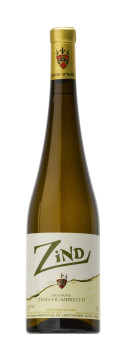
Technical presentation
| Bottling : | February 2018 |
|---|---|
| Acquired alcohol : | 12.5 ° |
| Residual sugar : | 2.4 g/l |
| Total acidity : | 3.6 g/l H2SO4 (5.6 g/l Tartrique) |
| pH : | 3.15 |
| Yield : | 65 hl/ha |
| Optimum tasting : | 2020-2031 |
| Average age of vines : | 27 years |
| Terroir : | Clos Windsbuhl |
| Sweetness index : | 1 |
| Soil : | Muschelkalk calcareous, South East facing |
Description of the wine Zind 2016
In 1989, when we had to decide on the plantation of the south side of the Clos, nearest to the forest, we opted for the Chardonnay grape, with the clear intention to produce a still wine, blending it with Auxerrois grape also located near the Clos. The cooler climate and rocky limestone, rich in magnesium (the Windsbuhl limestone is of the dolomitic type) felt ideal for Chardonnay. We were also looking for higher acidity, in a global warming context, and we met eventually all our expectations. Sadly, the Chardonnay is only allowed for sparkling wines in Alsace, hence the presentation as Vin de Table. 2016 produced a generous crop of beautiful healthy grapes. The wine fermented slowly, as usual, and finished dry.

Tasting notes
02/2018 : Pale bright yellow colour. The nose is elegant, announcing a mineral packed wine. The influence of the limestone is obvious: light reductive character, almost Riesling like, in need of time and air. Lots of citrus fruit on the palate, nice salivation and zesty ripe acidity, with no aggressiveness. This wine possesses a delicate language, the finish has a medium length with a broad mouthfeel and pure balance. This should be a very easy wine to use, not overwhelming showing all the characteristics of a great vineyard.

The Clos Windsbuhl of Hunawihr
The altitude of the vineyard coupled with Hunawihr’s tardy climate means that the Clos Windsbuhl is often one of the last of our vineyards to be harvested. This explains the aromatic quality of the Clos’ wines and the consistent balance of acidity, a guarantee of good ageing. Although often harvested late, the Windsbuhl grapes are only rarely botryitized, doubtless due to the altitude of the vineyard, but nevertheless often reach high levels of maturity.